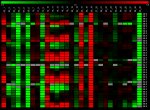


| People | Alumni | Positions | Events |
| Current Projects |
| Publications |
| Theses |
| Computer Facilities |
 |
Home |
|
 |
Imprint |  |
Sitemap |  |
Intranet |  |
Contact |  |
Links |  |
 |
 |
© 2010 - 2025 Thallinger Lab · Institute of Biomedical Informatics ·
Graz University of Technology · Stremayrgasse 16/I, 8010 Graz, Austria Tel +43-316-873-5343 · Fax +43-316-873-105343 · URL http://genome.tugraz.at · |
| GENERAL DESCRIPTION |
|
The accurate measurement of the lipidome permits insights into physiological and pathological processes.
Of the present high-throughput technologies, LC-MS/MS especially bears potential of monitoring quantitative
changes in hundreds of lipids simultaneously. In order to extract valuable information from huge amount
of mass spectrometry data, the aid of automated, reliable highly sensitive and specific analysis algorithms
is indispensable. We present here a novel approach for for the identification of structural information of lipids. We achieve automated and reliable annotation of lipid species and their molecular structures in high-throughput data from chromatography-coupled tandem mass spectrometry using decision rule sets embedded in Lipid Data Analyzer. Using various low- and high-resolution mass spectrometry instruments with several collision energies, we proved the method's platform independence. We propose that the software's reliability, flexibility, and ability to identify novel lipid molecular species may now render current state-of-the-art lipid libraries obsolete. For MS1 data, reliability is provided by two major innovations: 1) a 3D algorithm that confines the peak borders in m/z and time direction and 2) the use of the theoretical isotopic distribution of an analyte as selection/exclusion criterion. The presented algorithm has been applied to data from a controlled experiment and to biological data, containing analytes distributed over an intensity range of 10^6. Our approach shows improved sensitivity and an extremely high positive predictive value compared to existing methods. Consequently, this application is a valuable improvement in the high-throughput analysis of lipids. |
CITATIONS |
| MSn annotation algorithm using decision rule sets: |
|
1: Hartler J*, Triebl A*, Ziegl A, Trötzmüller M, Rechberger GN, Zeleznik OA, Zierler KA, Torta F, Cazenave-Gassiot A, Wenk MR, Fauland A, Wheelock CE, Armando AM, Quehenberger O, Zhang Q, Wakelam MJO, Haemmerle G, Spener F, Köfeler HC, Thallinger GG. Deciphering lipid structures based on platform-independent decision rules. Nature Methods. 2017;14(12):1171-1174. PM:29058722 |
| MS1 quantitation and peak selection algorithm: |
|
2: Hartler J, Trötzmüller M, Chitraju C, Spener F, Köfeler HC, Thallinger GG. Lipid Data Analyzer: unattended identification and quantitation of lipids in LC-MS data. Bioinformatics. 2011;27(4):572-577. PM:21169379 |
| Extension for oxidized lipids: |
|
3: Krettler CA, Hartler J, Thallinger GG. Identification and Quantification of Oxidized Lipids in LC-MS Lipidomics Data. Studies in Health Technology and Informatics. 2020. 271:39-48. PM:32578539 |
| Extension for sphingolipids: |
|
4: Hartler J, Armando AM, Trötzmüller M, Dennis EA, Köfeler HC, Quehenberger O. Automated Annotation of Sphingolipids Including Accurate Identification of Hydroxylation Sites Using MSn Data. Analytical Chemistry. 2020. 92(20):14054-14062. PM:33003696 |
| Extension for glycosyl inositol phospho ceramides: |
|
5: Panzenboeck L, Troppmair N, Schlachter S, Koellensperger G, Hartler J, Rampler E. Chasing the Major Sphingolipids on Earth: Automated Annotation of Plant Glycosyl Inositol Phospho Ceramides by Glycolipidomics. Metabolites. 2020. 10(9):375. PM:32961698 |
| Extension for accurate quantification of coeluting TG quantity based on MSn spectra: |
|
6: Vigor C, Züllig T, Eichmann TO, Oger C, Zhou B, Rechberger GN, Hilsberg L, Trötzmüller M, Pellegrino RM, Alabed HBR, Hartler J, Wolinski H, Galano JM, Durand T, Spener F. α-Linolenic acid and product octadecanoids in Styrian pumpkin seeds and oils: How processing impacts lipidomes of fatty acid, triacylglycerol and oxylipin molecular structures. Food Chemistry. 2022. 371:131194. PM:34600364 |
| Extension for gangliosides: |
|
7: Hohenwallner K, Troppmair N, Panzenboeck N, Kasper C, El Abiead Y, Koellensperger G, Lamp LM, Hartler J, Egger D, Rampler E. Decoding Distinct Ganglioside Patterns of Native and Differentiated Mesenchymal Stem Cells by a Novel Glycolipidomics Profiling Strategy. JACS Au. 2022. 2(11):2466-2480. PM:36465531 |
| Extension for shotgun and FAIMS shotgun: |
|
8: Hohenwallner K, Lamp LM, Peng L, Nuske M, Hartler J, Reid GE, Rampler E. FAIMS Shotgun Lipidomics for Enhanced Class- and Charge-State Separation Complemented by Automated Ganglioside Annotation. Analytical Chemistry. 2024. PM:39028917 |

|

Project P26148 |
|
Support: |

|

|
| DESCRIPTION | NEWS | DOCUMENTATION | FAQ | LICENSE | DOWNLOAD | STUDY DATA |